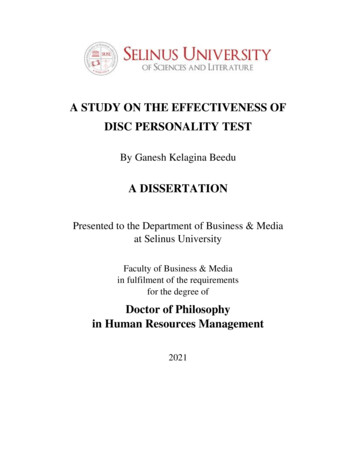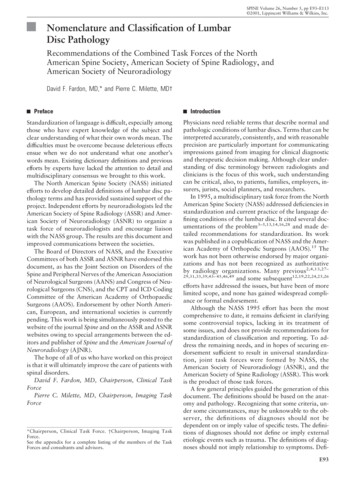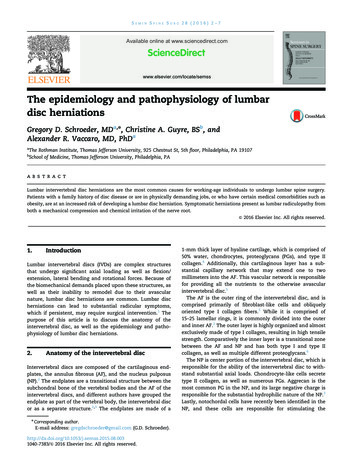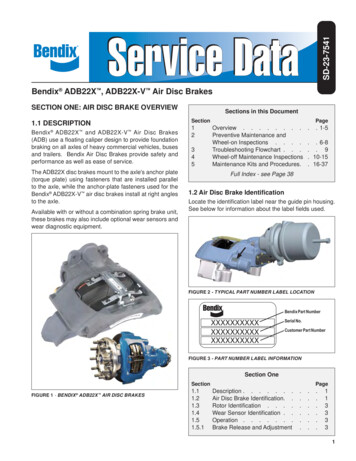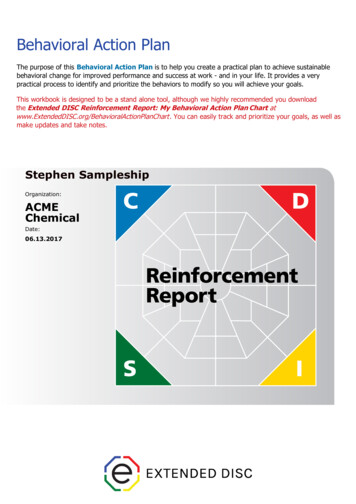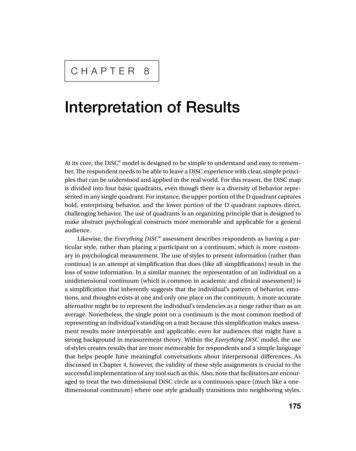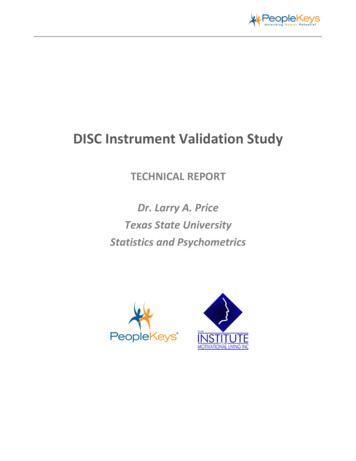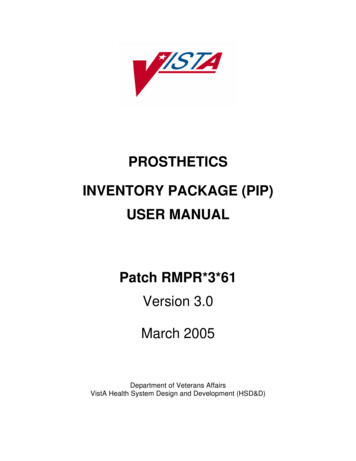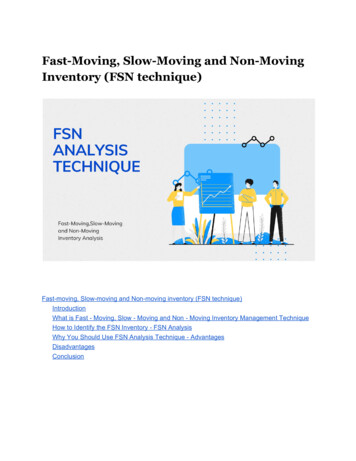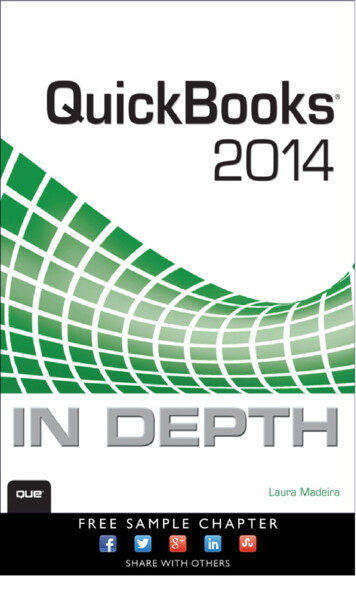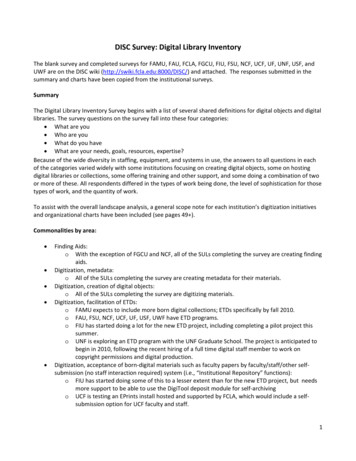
Transcription
DISC Survey: Digital Library InventoryThe blank survey and completed surveys for FAMU, FAU, FCLA, FGCU, FIU, FSU, NCF, UCF, UF, UNF, USF, andUWF are on the DISC wiki (http://swiki.fcla.edu:8000/DISC/) and attached. The responses submitted in thesummary and charts have been copied from the institutional surveys.SummaryThe Digital Library Inventory Survey begins with a list of several shared definitions for digital objects and digitallibraries. The survey questions on the survey fall into these four categories: What are you Who are you What do you have What are your needs, goals, resources, expertise?Because of the wide diversity in staffing, equipment, and systems in use, the answers to all questions in eachof the categories varied widely with some institutions focusing on creating digital objects, some on hostingdigital libraries or collections, some offering training and other support, and some doing a combination of twoor more of these. All respondents differed in the types of work being done, the level of sophistication for thosetypes of work, and the quantity of work.To assist with the overall landscape analysis, a general scope note for each institution’s digitization initiativesand organizational charts have been included (see pages 49 ).Commonalities by area: Finding Aids:o With the exception of FGCU and NCF, all of the SULs completing the survey are creating findingaids.Digitization, metadata:o All of the SULs completing the survey are creating metadata for their materials.Digitization, creation of digital objects:o All of the SULs completing the survey are digitizing materials.Digitization, facilitation of ETDs:o FAMU expects to include more born digital collections; ETDs specifically by fall 2010.o FAU, FSU, NCF, UCF, UF, USF, UWF have ETD programs.o FIU has started doing a lot for the new ETD project, including completing a pilot project thissummer.o UNF is exploring an ETD program with the UNF Graduate School. The project is anticipated tobegin in 2010, following the recent hiring of a full time digital staff member to work oncopyright permissions and digital production.Digitization, acceptance of born‐digital materials such as faculty papers by faculty/staff/other self‐submission (no staff interaction required) system (i.e., “Institutional Repository” functions):o FIU has started doing some of this to a lesser extent than for the new ETD project, but needsmore support to be able to use the DigiTool deposit module for self‐archivingo UCF is testing an EPrints install hosted and supported by FCLA, which would include a self‐submission option for UCF faculty and staff.1
UF released the myUFDC self‐submittal tool for UF's Institutional Repository and myDLOC forprojects with non‐UF members in September. It's linked from the top of all UFDC and dLOCpages and through this direct link: http://www.uflib.ufl.edu/ufdc/?m hmho USF’s digital repository has a deposit module. USF has also recently entered into anagreement with Berkley Electronic Press to use its Digital Commons product for a USFinstitutional repository featuring faculty papers. The scope, processes, and procedures forimplementation of this project are being developed. USF is also planning to launch DigitalCommons to support a USF institutional repository within the next two years.Digital Library/Collection hosting:o FIU, UCF, and UF host their own digital libraries/collections, handling all aspects of the hosting,ingest processing, and user support for their hosted collections. UCF and FIU also contribute toPALMM collections hosted on FCLA's DigiTool. Some of the image class legacy UF PALMMmaterials from DLXS have been migrated to DigiTool, butno text‐class items.o UCF is testing an EPrints install hosted and supported by FCLA.o USF currently manages and hosts all of their own locally created digital libraries/collections viaa local installation of DigiTool and no longer contributes materials to PALMM collections onFCLA's DigiTool. This includes images, e‐books, documents, text, audio, and video. The USFLibraries have approximately 60,000 licensed objects in DigiTool.o UWF Libraries provide both hosting and support of digital collections depending on SpecialCollections and Archives or external needs.Digital archiving:o FIU, UCF, and UF maintain their own internal archives as well as send materials to FCLA’s FDA.o FSU uses MetaArchive for some materials and sends others to FCLA’s FDA.o USF maintains its own internal archive and plans to deposit into FCLA’s FDA within the next sixto twelve months. The USF Libraries currently create and maintain a multi‐copy opticaldisc‐based archive of locally created digital collection content (archival masters). This archivecontains all of the content created during nearly fourteen years of digital collection building.The USF Libraries use a simple database for tracking. Libraries staff have yet to deposit any ofthis content into the FDA archive but plan on making a major effort to get all of this digitalcontent into the FDA in conjunction with the migration to a new digital asset managementsystem.o All other responding SULs send materials to PALMM or ETDs hosted by FCLA, which FCLAautomatically ingests into FDA. The automatic ingest is also done for ETDs from FSU, UCF, andUF.Training:o With the exception of FGCU and NCF, all respondents train for new skills and software and alloffer some level of training to others in their libraries, and/or on their campuses, and/or aspart of the coordination for collaborative work. Specific training offered by institutionsincludes: FAMU offers training on creating metadata, proper handling of materials,CONTENTdm, and related finding tool software. FAMU and USF conduct training on scanning. USF provides training on image processing, quality control, and PDF and e‐bookgeneration. FAU, FCLA, FSU, UCF, UF, UM, and UWF conduct training on finding aids. FCLA offers training on request on DigiTool. USF provides training in the use of the Deposit Module (for its local installation ofDigiTool).o 2
UF offers complete training on all aspects of digitization, with an emphasis on trainingfor dLOC on using the dLOC toolkit.UWF considers training an ongoing challenge.FIU’s GIS Center provides training to students and faculty in using and managinggeospatial data.FIU has offered complete training in digitization.Staffing levels (number of individuals and FTE) by function: The staffing levels for digitization activities vary widely from institution to institution. 5 respondentsindicated that they do not have a separate digital library or digital collections unit while 7 institutionsdo. Total FTE for those with a separate digital unit ranges from 1 to 12 with 4 institutions having 3 orfewer FTE. Extending beyond the digital library unit, the total number of FTE involved with digitallibrary initiatives at the institutions ranges from minimal to 15 with 4 institutions reporting 3‐6 FTE and2 institutions reporting 13‐15 FTE. Please see pages 14‐15 for details. Staff at ten of the institutions has acquired expertise with particular formats or services. Please seepage 16 for details. Complete descriptions of staff involved in digitization activities include a description of the activitiesand the number of FTE within each function. Please see pages 16‐28 for detailed explanations of:o Digitization (in house or ingest/processing of vended materials) of any material typeo Facilitation of other digital materials (ETDs, IRs, and born digital)o Hosting and supporting online collections (web designers, DL system support, etc)o Archiving and preservationo Cataloging and metadata creationo Digital library training, project management, and other roles specifically related to digitalproject activities Descriptions of additional activities and functions of interest performed within the overall FTE aredescribed on pages 27‐31 and include:o Data curation Six institutions reported involvement.o Grant funded projects Nine institutions reported involvement.o National or international digitization partnership Four institutions reported involvement Most all institutions reported that various departments in their libraries play a role in the coordinationof digital projects. Pages 31‐35 provide descriptions of the activities at each institution for thefollowing areas:o Systemso Technical Serviceso Public Serviceso Special Collections and Archiveso University Archivisto Collection Developmento Electronic Resources3
Internal committees, working groups or task forces concerned with digital initiatives are active at fiveof the institutions. See page 36‐37 for descriptions of these groups at:o FAMUo FAUo FIUo FSUo NCFo UCFo UFo USFSoftware tools currently in use: While no one automated system is used by all institutions to access and display digital collections,DigiTool is used by 9 respondents and 1 respondent has plans for using DigiTool. Four of those areusing their own DigiTool admin unit. A breakdown of these systems by institution is available on page37. All automated systems currently in use include:o DigiToolo DLXSo OJSo Digital Commonso Etd‐db platform developed by Virginia Techo CONTENTdmo Greenstoneo UFDCo Various web toolso Archono Open sourceo Mangoo MDIDo VCat With the exception of FGCU, all respondents indicated using additional software in the production ofdigital collections. For complete listings and staff expertise with software please see pages 38‐39.Selected software includes:o Adobe creation, production, and editing productso Flasho ABBYYo Drupalo EPrintso Camtasiao Sony Sound Forgeo XML‐related toolso LOCKSSo MD5 Checksumo Roxioo Dreamweaver4
oooooooooooooAnimotoSliderocketCoolirisImageMagick v6Final Cut StudioMplayer/MencoderMPEG StreamclipHandBrakeAudacityGarage BandOmni Page ProPrime Recognition OCROPSLevel of integration with FCLA digital library services / Level of participation in PALMM / Level ofparticipation in FDA The level of integration with FCLA digital library services is divided into several categorieso The level of participation in PALMM (apart from Archives Florida) ranges from none to heavilyinvolved. Complete descriptions are available on pages 39‐40. One institution indicated no involvement Four institutions indicated past involvement Five institutions indicated current and/or upcoming involvement Responses indicated that five institutions are currently using FCLA’s DigiTool for InstitutionalCollections. Complete descriptions are available on page 40. Six institutions indicated some type of involvement with DLS services for Finding Aids (Archon, ArchivesFlorida, or Opening Archives). Complete descriptions are available on page 41.o Participation ranged from low/minimal to higho UCF and UF indicated high/maximum involvemento FAMU, FSU, UNF, and USF acknowledged participation and contributionso UWF is a heavy participant for its own generated DLS services for Finding Aids particularlymaking use of its own server installation of Archon. Participation with the Florida Digital Archive is evident for eight of the institutions. Completedescriptions are available on pages 41‐42.o Several indicated high or extensive involvemento FSU is most recent participant Overall the level of participation with DLS services for ETDs is low. Complete descriptions are availableon pages 42‐43. However, it is important to note that:o UCF’s ETDs continue to be served by FCLA with a high level of reliance and involvement.o UWF is a participant and this service seems to be functioning adequately for ETD ingest andlater cataloging and display in the catalog.o FAU’s ETDs are hosted in their institutional DigiTool Admin unit which is supported by FCLA.5
The level of participation with DLS services for Institutional Repositories (DigiTool Deposit or EPrints) ismoderate. Complete descriptions are available on pages 43‐44.o FAU and FSU are using DigiTool for their IRs, but continue to manage all ingest procedures.o UCF is currently testing an FCLA test install of EPrints.o FGCU hopes to use DigiTool an IR/electronic archives in future. Most institutions described their library’s use of DigiTool to be in the beginner to intermediate range.Complete descriptions are available on page 44.o Three institutions indicated simple submissionso Two institutions indicated more advanced submissions such as ingesting manifestations andusing CSV files.o One institution indicated a growth in sophistication and complexity Staff experience and expertise was rated low to moderate with regards to DigiTool. Completedescriptions are available on pages 44‐45.o Several indicated the lack of user‐friendlinesso Difficulty with workflows and submission requirementso Key is establishing the workflow for staff to followo More training and documentation neededo Ask that FCLA provide must do a better job at significantly more training on these tools as thetraining/education requirements are not adequateo FCLA could greatly aid in collaborating with organizations such as Lyrasis to provide trainingEquipment currently in use In addition to the software used, each digital collections unit relies on a variety of equipment.Complete descriptions are available on pages 46‐49 for:o Computerso Cameraso Scannerso Audio recorderso Video Recorderso Storageo OtherPlanning for the future: In addition to the questions posed by CSUL, DISC wanted to include some information regarding ourneeds, plans, goals, and issues to help plan for the future. Detailed descriptions are available in eachinstitution’s survey. A wish list of current needs for the institutions surveyed includes:o For digitization (particular formats?) .JPG file, .PDF file, set of .PDF file, .SWF Flash file, RTF, and audio Newspapers; oversized sheets like posters and maps Photographs and other images6
Development of digitization tracking database and automated report reporting andstatistics for building digital collections and/or digitization activities in PDF, JPG/JP2,TIFF, PDF/A, and METS format.DSLR camera with book cradle, high speed scanner and large format scanner needed(newspapers).Complete migration of materials to remove them from the queue to reduce overheadand improve production.There is a need for general and specialized education with regards to digitization byFCLA in both present and future possibilities. For example, the Library of Congressrecently completed a Flickr/Folksonomy image digitization project which is beingfollowed by various academic libraries across the country. These newermethodologies should be continually explored and disseminated by state institutionssuch as FCLA.oFor digital library functionality Better support for METS Need to build an electronic library platform Become more collaborative with other departments and efficient in the building anddelivery of digital collections Self‐submittal tool, especially using DigiTool with support and training Online metadata editing Bookshelf/favorites Interactivity, Social Networking and Web 2.0 methodologies (i.e. Mashups) are alldigital library functional requirements that are present on other state and nationallevels and need to be brought into Florida state libraries and the wider state system oflibraries.oFor archiving and preservation Work more with FCLA to develop more efficient submission and tracking workflows forFDA. Better support for automated transfer of multiple manifestation objects from DigiToolto FDA ( Our understanding is that beta procedure can only handle singlemanifestations) As a new member to FDA, work towards developing digital preservation policies andprocedures that encompasses automatic and efficient use of FDA and MetaArchive asdigital preservation strategies for digital collections master files. Faster FDA ingest Established method and timeline way to get files from FDA FCLA is doing an adequate job at migrating formats and preservation, though perhapstoo much time is being spent on this area while other areas outlined heretofore suffer.Education and wider dissemination other than simply placing this as information onFCLA's website is needed for the broader community to flourish. While the USF Libraries continue to maintain their own optical disc‐based archive of alllocally created digital content, staff does plan on utilizing the FCLA FDA services. Theplans seek to accomplish this during the migration of USF content from DigiTool toFedora Commons over the next six‐twelve months. Expected needs in regards to7
support from FCLA staff are minimal – only that they will be available for consultation.Libraries staff are also exploring an offer from USF’s central IT department to store theLibraries’ digital collections archives disks at an off‐site facility (Iron Mountain). We have a large archive of institutional materials as well as some manuscripts andpapersooFor metadata creation It would be very helpful to have statewide guidelines documents on what metadatagoes where and what metadata is prescribed for what type of collections. The workinggroup from DISC and metadata SC is currently working on such a document, but untilthat document is available some general guidelines would be very helpful. METS maker for ingesting into DigiTool and for direct ingest into FDA. Work closely with the Cataloging department to develop best practices for metadatacreation along with utilizing metadata creation/PREMIS expertise best practices fromDISC/CSUL member institutions. Ingesting and integrating other data sources (http://id.loc.gov/authorities/; EADs,EACs/life events) as needed overall and for specific projects. Training in software markup. Workshops on standards of Metadata creation and how this metadata fits into largerproduction cycles are sorely needed. Metadata methodology workshops are needed asis broader dissemination of information regarding the current trends towards taggingand folksonomy for technical services. Catalogers versed in older methodologies needto be educated so that these new methodologies are not perceived as a threat and sothat they may make the successful career transition to working on metadata projectsand ensuring career longevity. We need to train our catalog librarian.For collaboration It would be helpful to have a wiki or a blog or some common place where differentinstitutions can post their current digital projects which they are looking to collaboratewith other institutes for. Better collaboration on related digital library development. Better collaboration on Everglades related digital library development, though we arethrilled to be working with UF on this. Work closely with others to develop a digitization‐tracking database, participate innational/international digitization projects, and collaborate on future grantopportunities. Find collaborative opportunities for leveraging shared resources. Wider collaborations need to be engendered between and among institutions and abetter and more complex relationship model needs to be instituted rather than anFCLA central repository with larger satellite institutions left to simply ftp batches ofcollections with regards to digitization. A more complex, dynamic and 21st centurycollaborative model is needed here taking into account present trends and needs.8
o The USF Libraries seek to collaborate with other institutions to build collections ofnational and international research value in fields that support the University’sstrategic goals.We are interested in partnering with other institutions on digitization projects. Wehave materials on holocaust/genocide that are targets.Other It would be very beneficial to have statewide guidelines on specifications for OCR that areneeded to say submit materials into the newspaper Florida Digital Newspaper library andbetter instructions on how to submit to that collection. We don’t have the infrastructure for any large‐scale digitization project although we havea couple of candidates as described above, as well as a desire to implement ETDs. Wewould need to add at least one FTE to our technical services department to createdescriptive metadata. There is a need for copyright clearance routines and continuing training in metadatacreation and other topics. There is a need for shared training and documentation to share lessons learned and gaineconomies of scale. Our greatest obstacle is our size and overall lack of technological skills. Training is apriority.An overview of institutional goals:oEach institution was asked to list their long term and short term goals. Our short term and long term goals include collection materials and building our IR andalso to collaborate with more SUS libraries on joint, new PALMM collections. We are reallyinterested in contributing to collections in PALMM because they represent collectiveefforts of collaboration between the SUS, and this is a great resource and asset, especiallywhen funds and resources are shrinking with budgetary constraints. In the short term, Cook Library hopes to continue to build its New College Thesis databaseand develop the Smart Library project (i.e. art image database). Long term, we would liketo examine unique holdings for potential digitization. Our short term goal is to finalize the pilot project. Our long term goal is to serve as a digitalrepository for the institution. Our short term goals are to integrate digital initiatives underway across five librarydepartments, and to set priorities for investment in those projects. Our long term goalsare to expand digital initiatives in programmatic areas and to support researchinfrastructure needs of the university. The major short term goal for digital collections is to complete the migration from DLXS toDigiTool and OJS, in order to retire DLXS. Our long term goals are guided by CSUL inconsultation with DISC and other groups. Short‐term goals for the FSU includes: establishing clearly defined and efficient workflowsto support ongoing digitization projects; performing quality control and full cataloging forpreviously digitized collections; creating a preservation policy for digital collections; andimproving promotion of and access to digital collections. Long‐term goals include:identifying collections for digitization using criteria in FSU’s “Collection Development Policy9
for Digital Collections”; identifying potential partnerships on and off campus; and applyingfor grant funds to support digitization of larger collections of material owned by the FSULibraries.Short term goals: Complete grant for Central Florida Memory – deadline is Sept. 30thandlaunch PRISM – Political & Rights Issues & Social Movements PALMM collection. Longterm goals: Develop an Institutional Repository model for UCF.Increase automation and overall processing ease to increase production and enhancesupport for digitized materials.Supporting preservation and access, adding maximum functionality, and along withmaximum overall growth in the digital collections and digitization production (in terms ofthe quantity, quality, and variety of materials as well as the reliability of the productionprocess).ETD exploration with the UNF Graduate School, and retrospective conversion project ofUNF print theses and dissertations. We hope to have a trial project to accept new thesesand dissertations as files, with eventual transfer to DigiTool. The Project is anticipated tobegin in 2010, following the hiring and training of a full time digital staff member to workinitially on copyright permissions and then digital production. The Library will explorevarious institutional repository options, including acquiring a DigiTool ADM unit.Continue to scan University archival materials e.g., alumni journals, campus newslettersand newspapers.Create EAD finding aids via Archon for selected University archival materials, withingestion into Archives Florida.Short term, we’re accepting collections that are donated to us and keeping them as safe aswe can in our archives. Long term, we’d like to have these special collections digitized andcataloged in PALMM.Hopefully, to generalize, UWF Digital Initiatives needs to keep congruent with currenttrends in the wider IT sphere so that the UWF Libraries maintain their place as a vitalcenter for information dissemination and gathering for the campus and wider community.Perhaps like the rest of the state, UWF is in a retrenched budgetary situation currently andwith this maintaining a minimal level of present initiatives is perhaps paramount.Short‐term goals (1‐2 years): Migrate all digital collections from DigiTool to FedoraCommons; complete integration of LibGuides and Flex Builder public interfaces; submitUSF Libraries digital collection content to FDA; launch Digital Commons to support USFinstitutional repository; and develop and document efficiencies in all phase of digitalcollection building.Long‐term goals (3‐5 years): Implement a digital collections project tracking softwaresystem; create a Holocaust & Genocide Studies information portal; increase grant fundedprojects to support USF Libraries strategic initiatives; develop integrated video/text publicinterface for searching and presenting oral history interviews.Each institution was asked if they had institutional assets to share:oTen institutions indicated that they had institutional expertise to contribute to others. FAMU ‐ Will share what we know. FAU – Audio and video digitization, books, broadsides, photographs FGCU ‐ Enthusiasm and willingness. FIU ‐ Yes, geospatial data manipulation and curation10
FSU ‐ We believe we are ahead of the curve in having a digital initiatives collectiondevelopment policy and are happy to share this with others.UCF – Experience using multiple content management systems. CONTENTdm experience inparticular.UF ‐ Yes, especially for serials, newspapers, the Digital Library of the Caribbean, museumobjects/artifacts, and on training, support, and set up for equipment. We also haveMARCXML record feeds that others can ingest into their catalogs. For SULs, the records arein MANGO, but for others the records can still be ingested, which supports the expandedcooperation goals for Florida’s academic cooperation0309.html).USF ‐ Yes. USF remains willing to assist FCLA and other state universities to the degreepossible given available resources.UWF ‐ web 2.0 and open source methodology expertise and expertise with new digitallibrary methodologies that may be valuable to share, especially with the smaller andmidsized SUS institutions that do not have large IT staffs to devote to these initiatives.UNF – We are happy to collaborate and share our expertise with other institutions.oFive institutions indicated that they had resources that could be pooled or leveraged, and twoothers indicated willingness to explore the possibility. FAMU ‐ Open to explore this. FAU – resources for audio, video and specific monographs (books, broadsides,photographs) digitization. FIU ‐ Yes, hosting data (and infrastructure for mapping applications) FSU ‐ We have several large collections of international significance that are primecandidates for digitization as part of consortial efforts. These collections includeNapoleonic‐era materials and the papers of Nobel Laureate Paul A.M. Dirac. UCF – CONTENTdm UF ‐ We’re at or over capacity, but we’re always looking for ways to work more efficiently.Working collaboratively can be a great help in finding ways to leverage shared resources todo more work with fewer resources. USF ‐ Yes. If USF deems a collaborative project furthers the university’s strategic goals, USFLibraries remain willing to pool or leverage resources. Current examples include dLOC andMVI.oWhen asked if there was a current capacity or capability to take on new work for free or for a fee,only one institution responded yes. However, four others indicated that they would be willing butwould need to reprioritize or plan for such an undertaking or charge fees. Others indicated theneed to complete legacy work before making such a commitment.Most all institutions indicated future plans or desires. A sampling includes:ooWork with for digital projects because it ensures us that we are doing things consistently withstatewide initiatives and FCLA has the expertise needed in Digital Collections that we can turn tofor consultation.We are very interested in seeing the outcome of the document that DISC has been discussinglately stated “DL systems requirements.” While no system will meet all our needs, it would be niceto have a robust enough system that meets most of our needs and we have good technical supportfor.11
oooooooooooooI would like to see the recommendations of the Janus Recon Task for taken seriously and actuallyimplemented. These recommendations include devoting 1% of the Libraries' collective collectionsbudget to digitization, focusing on digitization of special collections, and centralizing infrastructure.Important digital collections are scattered throughout the SUS (not to mention the state). Floridaon Florida only aggregates collections pertaining to Florida, and has no full text capability. Weshould put policies and technologies in place to de‐Balkanize our digital resources, cooperate morenot only within the SUS but on a statewide level, and capitalize on the strengths of the collective.We want to transition from a proof‐of‐concept model to an integrated digital library program.Expansion of UFDC for further extensibility and robustness, including:o Automatic connection to preservation system and space (see Duraspace and NLM’s Fedorainstance as models)o Ongoing refinements to UFDC’s Lucene indexing (Lucene is an enterprise‐level, opensource software for indexing)Greater automation overallThe Library will explore various options, including acquiring a DigiTool ADM unit.Ideally we would build some in‐house capacity for digitization and description, rather than need
o FAU, FSU, NCF, UCF, UF, USF, UWF have ETD programs. o FIU has started doing a lot for the new ETD project, including completing a pilot project this . o UNF is exploring an ETD program with the UNF Graduate School. The project is anticipated to begin in 2010, following the recent hiring of a full time digital staff member to work on .
